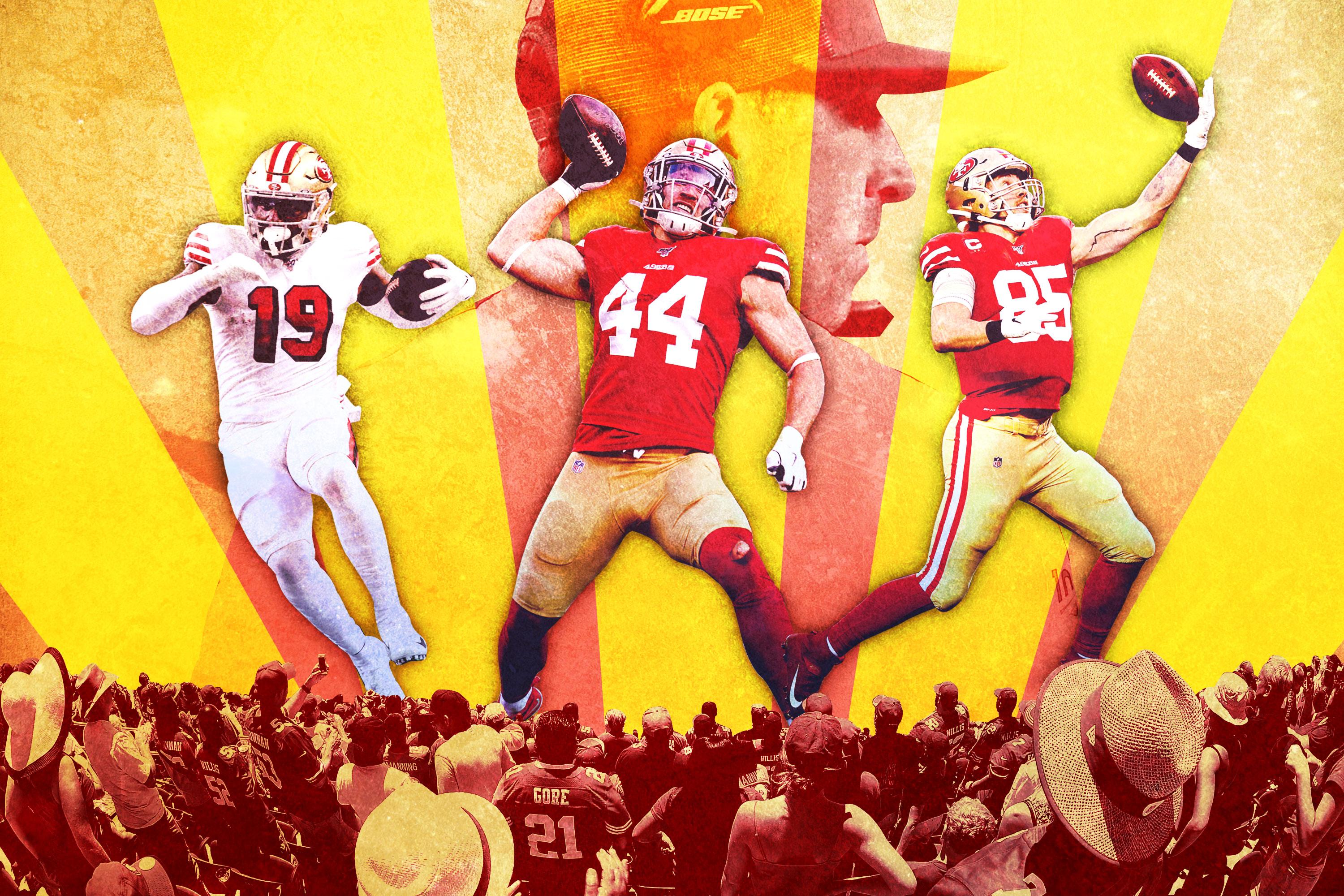The 49ers’ Swiss Army Knife Playmakers Are the Key to Beating the Vikings
With George Kittle, Deebo Samuel, and Kyle Juszczyk, Kyle Shanahan has the do-everything playmakers he needs to create chaos against opposing defenses. San Francisco’s schematic versatility could be crucial to a long playoff run.
The 49ers’ star-studded defense has gotten plenty of attention this season, with headliners like Richard Sherman, Nick Bosa, Fred Warner, Arik Armstead, and DeForest Buckner leading the team on its climb to the top of the NFC West. But San Francisco’s offense, the schematic brainchild of head coach and play-calling wunderkind Kyle Shanahan, has been a major factor in the 49ers’ ascension too―and that group has a chance to steal the limelight in this weekend’s divisional-round tilt against the Vikings.
With Jimmy Garoppolo at the helm, San Francisco’s offense certainly has its work cut out for it against a tough Minnesota defense, which gave Drew Brees and the typically explosive Saints fits in the wild-card round. But Shanahan’s scheme has a leg up in its unmatched ability to create chaos; it’s an extraordinarily flexible system that puts opposing defenses on their heels and out of position thanks to its run/pass balance, heavy doses of misdirection, and, most importantly, its uniquely versatile collection of playmakers. The team’s trio of Swiss Army knife weapons―tight end George Kittle, receiver Deebo Samuel, and fullback Kyle Juszczyk―could be key to solving Minnesota’s smothering defense.
Shanahan’s offenses have long been characterized by an emphasis on the wide-zone run game and an explosive play-action passing attack, but the system he’s built in San Francisco has evolved from those he ran previously in Atlanta and Cleveland―particularly in the styles of personnel he’s looked for to fill key roles. Along with general manager John Lynch, Shanahan has spent the past few years assembling a group of multitalented skill players who either straddle positional archetypes or bring unique athletic abilities to the table―or both.
The result: The 49ers offense runs largely on the schematic advantages that Kittle, Samuel, and Juszczyk create. That core group is bolstered by exceptionally explosive and versatile running backs Matt Breida, Raheem Mostert, and Tevin Coleman. And San Francisco has gotten a boost from veteran receiver Emmanuel Sanders after trading for the former Bronco midway through the season. (The team made that move in part because positionless rookie Jalen Hurd got hurt and their attempts to trade for the highly versatile Mohamed Sanu fell through. See a pattern?) Sanders has shown the ability to be more than just a traditional receiver in his short time in San Francisco, too; he tossed a touchdown pass to Mostert in the team’s Week 14 win over the Saints.
As Falcons tight end Austin Hooper told Bleacher Report’s Adam Lefkoe in May, Shanahan’s strength as a play designer is his “ability to put specific people in great positions for success—specifically game-planning off one or two defenders.”
Per Hooper, Shanahan told players, “if they ever roll up into a seven-man box against us, Devonta [Freeman], you better have 150 yards rushing today. Soon as they go eight-box, Julio [Jones], we’re going to do that play-action drift route across the middle and you’re gonna take it.” Shanahan’s strategic bedrock—the ability to adapt on the fly and attack a defense’s weaknesses—is a big reason the 49ers finished second in points per game (29.9) and seventh in offensive DVOA in 2019, despite missing both of their starting tackles for the majority of the year and playing without a true no. 1 receiver.
The team’s strength is its flexibility. Shanahan’s built an offense that gives him nearly limitless play-calling freedom: Whether the team is in its signature heavy two-back/two-tight-end looks or lined up in more spread-out three-wide sets, the 40-year-old play-caller has the chameleons in place to attack defensive vulnerabilities both on the ground and through the air. Nominally, San Francisco’s lined up with two-running-back or two-tight-end sets on 47 percent of its snaps this year, more than any other team except for the Eagles (54 percent), per Sharp Football Stats. But in practice, the team can run pretty much any de facto “personnel grouping” it wants because neither Kittle, Juszczyk, nor Samuel really fits into the standard personnel grouping taxonomy: Kittle’s part tight end, part receiver; Samuel’s part receiver, part running back; and Juszczyk’s part fullback, part tight end. It’s anyone’s guess what role they’ll be playing on any given play.
If teams go light up front and look to stop the pass, Kittle and Juszczyk can open up holes for the team’s backs to run through. Hell, those two are such good blockers, Shanahan’s comfortable dialing up runs even when teams load up to stop it. We saw that in Seattle in Week 17, when Kittle and Juszczyk combined to spring Mostert for a big gain.
Crucially, though, when an opponent sells out to stop the 49ers’ physical run game, the team’s hybrid players can convert into downfield pass-catching threats, too. Shanahan doesn’t have a Julio Jones in his receiving corps in San Francisco, but with the right amount of savvy scheming, he hasn’t really needed one. The team created plenty of explosive plays through the air—even with its tight end and fullback. Against the Packers, Kittle used his top-tier athleticism to get himself open then outrun the defense for a 61-yard touchdown.
Juszczyk has been a target on some deep throws, too. When matched up against a linebacker, the seventh-year pro has enough speed to burn past coverage and the reliable hands to reel in passes.
Juszczyk is a threat in the short and intermediate areas as well, a joker card that Shanahan can deploy out on the wing, in the backfield, or as a wing back somewhere in between.
If he’s feeling extra saucy, Shahanan will dial up a speed-option play with his jack-of-all-trades fullback, as he did against the Saints.
Kittle provides similar versatility, but with more game-wrecking flair. He’s a technically sound route runner with a beast mode ability to plow through tackles. Against the Cardinals, he took a short slant on third-and-3 and, well, did this:
Kittle is the team’s unquestioned go-to guy in high-leverage situations. In San Francisco’s barn-burning win over New Orleans, the big tight end caught this pivotal pass on fourth-and-2, rumbled for 39 yards (plus another 15 for the face-mask penalty), and set up the game-winning Robbie Gould field goal.
Kittle won All-Pro honors in 2019 after catching 85 passes for 1,053 yards and five touchdowns. Crucially, he got some help in the big-play department over the second half of the season. Samuel emerged as a reliable playmaker for the 49ers, particularly down the stretch, with the rookie Tasmanian Devil–esque pass catcher finishing the year with 961 yards from scrimmage (802 yards through the air, 159 on the ground) and six total touchdowns (three through the air, three on the ground). Whether he was taking a handoff from the wingback spot, running a slant, or taking an end-around for a big gain, Samuel emerged as an explosive complement to Kittle.
That dynamic YAC-creating duo gives Shanahan the ability to mess with opposing defenses, dressing up the same basic concepts by using different players to run them, often several times in the same game or even a few plays in a row. See: the team’s Week 17 win over Seattle.
Together, Kittle, Samuel, and Juszczyk give the 49ers an incredible variety of ways to keep defenses guessing. This three-play sequence from the second quarter of the team’s Week 16 win over the Rams served as an excellent example of how Shanahan can deploy his versatile playmakers. On the first play, Samuel motions to the right in what looks to be the same play from directly above, but instead of dumping the pass to Juszczyk (who slices across the line), he tosses it back to Samuel on a delayed screen that picks up 18. On the second play, San Francisco feigns a run to the left before coming back to the right, with Juszczyk the point man on the screen. That picked up another 23 yards. On the third play, the 49ers line up with Samuel and Mostert in the backfield. Samuel takes the handoff on a trap play up front and explodes to the outside, turning upfield before finding pay dirt.
On Sunday, the Saints struggled to run their offense against the Vikings’ smothering defensive front, with Brees taking three sacks, losing a fumble, and finishing with just 208 yards on 33 attempts. The few times New Orleans did get its offense going, Taysom Hill―New Orleans’s own Swiss Army knife player―always seemed to be right at the center of it. Intriguingly, the 49ers offense is built around some of the same principles that makes Hill one of Sean Payton’s favorite weapons: versatility, extraordinary athleticism, and some good old-fashioned deception. To get past Minnesota and earn a trip to the NFC championship game, Shanahan is going to have to pull out all of the stops on offense, and he’s got the right mix of playmakers to do it.
At the risk of spouting off too many coachspeak clichés, the San Francisco offense is just made up of a bunch of football players. With an All-Pro tight end who can block and catch passes, a receiver who can also be a running back, and a fullback who can do a little of everything, opposing defenses have struggled to spot tendencies or predict whether San Francisco is going to be a run or pass. With Shanahan’s heavy use of motion, play-action, and general schematic black magic, the 49ers have one of the most dangerous―and fun―offenses in the NFL.

